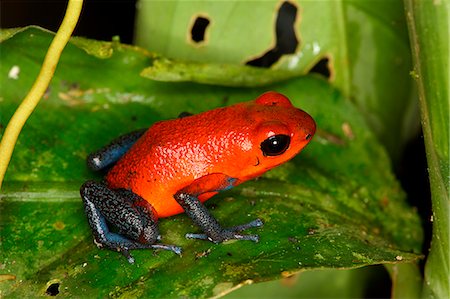ANIMAL: Strawberry Poison Dart Frog Oophaga pumilio Type of Animal: Frog Habitat: Humid forest, premontane forest, plantations, banana groves, abandoned clearings Location(s): Ranges from Nicaragua to NW Panama Appearance: Small strawberry-colored frog w/ blue on legs, variable dorsal coloration (there’s 15-30 known morphs), large dark eyes Food/Diet: Ants, mites, termites, flies, beetles, millipedes, insect eggs, small crickets, eggs of own species. Tadpoles strictly oophagous eating only unfertilized eggs. Status in Wild: Stable Conservation: Breeding in zoos, aquariums, & herpetoculture Lifestyle: Small groups of 2-8 frogs Additional Info: Called: Male Female Young: Tadpole Group: Army Weight: Male: 0.18 oz Female: 0.49 oz Gestation: 10 days Life Span: 3-6 years in wild, 8-12 years in captivity Body Length: Male: 0.67 in Female: 0.94 in Due to skin toxins, only a few snakes eat adults. Active during the day (diurnal). Females lay 3-5 eggs per clutch. When tadpoles hatch, female transports them to water-filled location. Each tadpole deposited singly. Tadpoles stay in tadpole stage for 1-2 months, then metamorphosing into froglets. Froglet stage lasts until 8-10 months old when maturity reached. They fight by wrestling each other. Most often deposit eggs in bromeliad axils but sometimes utilize small puddles, tree knots, & even cans. Both parents play parental role but female plays larger role, providing unfertilized eggs for tadpoles. Males make low buzz/tick calls to defend territory/attract females. Females usually initiate mating. Bright coloration serves as warning to potential predators. Brighter males also more territorial & likely to mate. Fun Fact(s): Used in medical research due to skin toxins being possible medicine source. Also called Strawberry Dart Frog, Strawberry Poison Frog, & Blue Jeans Frog (latter due to blue on legs). While toxic in wild, they lose much/all of toxicity in captivity due to diet. In captivity, they’re only fed nontoxic prey items, like crickets & fruit flies. In wild, they eat lots of toxic prey. Hunters use skin toxins on darts & arrows. To ensure clutch moist, male pees on eggs daily. Bright coloration serves as warning to potential predators.
